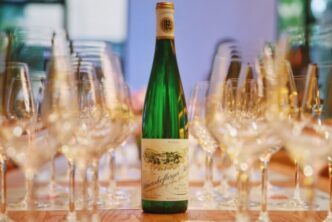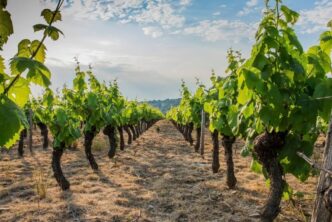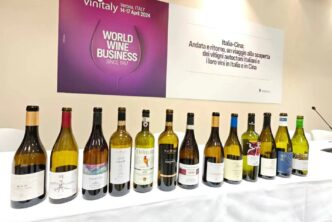I have found over the years that all true, real wine experts (“true” and “real” intended as really and truly knowing what they are talking about, not those who spray around 95 point scores like confetti at a marriage) share a normalcy of modesty, or if you will, a certain amount of wisdom to go along with all their knowledge. As the saying goes, knowing that the tomato is a fruit, not a vegetable, is an example of knowledge. But wisdom is knowing not to put it in a fruit salad. With wisdom comes the knowledge of knowing that to be humble, to listen rather than talk, will carry you a lot farther in life, if for no other reason, because it will help you learn, and in the process, gain knowledge and wisdom. These sorts know that if they listen, they learn. Anyone who has had the good fortune in life to listen and learn from, for example, Steven Spurrier, Aubert de Villaine, Giacomo Conterno of Aldo Conterno, and David Lett, knows exactly what I mean.
However, all the attention and all the modesty in the world won’t help you become a better wine taster if the scientific basis for that to happen isn’t in place. Or that, at the very least, one tries to recreate the ideal tasting conditions in which attentive wine tasting can be properly performed. So clearly, tasting eighty wines in one morning as is commonly done at many international wine competitions is not the way to go.
The biology of wine tasting
Though it might seem like a whole lot of fun, wine tasting professionally is in and of itself not especially easy (and I would venture to say that tasting one hundred wines in a day, even if carefully spaced out over eight hours or so, is actually not that much fun, either). Like any job in life that is done not just properly but done well, wine tasting in a knowing manner takes time, energy, talent and study. In fact, a lot of study, if you want to be truly good at it. Unfortunately, just picking up a glass and start drinking away doesn’t quite cut it, though of course a lot of people have fun in doing just that. Whether their impressions of the wine should be of any interest to anyone is another matter. That much admitted, studying the subject matter is not sufficient in and of itself. A proper tasting methodology would also be a big help in attempting to arrive at as complete and potentially useful an evaluation as possible. For example, while we tend to think, taste and write about wine while focusing on how that wine looks, smells and tastes, in fact there other senses that also come into play into helping us reach a conclusion about that wine. Though we don’t commonly associate our sense of hearing with wine tasting, research has shown that the sound a wine makes, or the sounds we are exposed to while drinking wine, will affect our perception of the wine we are drinking. To the point that depending on the kind of music being played, or simply how high or low a frequency tone is played while we drink, we will find the same exact wine to be powerful and structured one time, and fruity and refreshing the next. And if we drink that same wine in total silence, our impression of the wine changes again. Did you know that if you smell wine with your eyes closed that activates the olfactory cortex of our brains to a higher degree than if we taste with our eyes open? Which has clearcut implications on what you end up smelling. And did you know that 20% of our body’s total touch receptors are found in the mouth such that that placing a wine (or any liquid or solid, for that matter) in our oral cavities delivers a great deal more information to us than just that related to its taste? Each one of our senses is just as important as the next in evaluating something before us, and it is the combination of the information we glean by using all of them together that will ultimately help us arrive at the most thorough conclusion about that wine’s characteristics and qualities. That those conclusions may be right, wrong or even something we find ourselves in agreement with is another matter, of course. And this because we do not live (and taste) in a vacuum: so when we do taste wine, our past experiences, memories, preferences and still other factors that are impossible to dissociate from the act of wine tasting will contribute more or less greatly to the formation of an impression about the wine we are tasting.
When all is said and done, wine tasting involves receiving, analyzing, understanding, and ultimately evaluating the message that the wine in the glass is conveying to the taster. Therefore, there is both a sensory and a cognitive component to wine tasting.
The sensory component is clearly linked to our ability to receive impulses/stimuli through our receptors and afferent pathways and forwarding them to our brain, where these impulses are processed by cells (neurons) in specific parts of the brain (for example, there is an area of the brain that is specifically involved in recognizing smells while another identifies sounds) and to elaborate them appropriately.
The cognitive component refers to how our brain processes the impulses it receives: while the bio-chemical and neuro-physiologic reactions that allow us to see, smell and taste are clearly essential to wine tasting, they are by no means the only processes that take place in the evaluation of a wine. For every time we sip (or taste) something, the brain creates a “mental construction” of what it is we tasted or smelled, generating images, memories and emotions that are specific to, and the result of, our life experiences. There is, in other words, a “mental construct” that is put into place every time we smell or taste anything. The creation of the mental construct is a very complex affair, and laboratories all over the world are studying the function of brain circuits involved in sensory perception, memory and emotions, uncovering the key role of neuronal plasticity in olfactory learning and perception.
It follows that there exists a neuro-physiologic approach to tasting, that goes beyond simple sensory analysis, and is based on the many recent scientific discoveries that have helped us gain a much deeper, thorough understanding of the science of tasting, all of which cannot be reduced to the simple triad of “sight-smell-taste”. Wine tasting professionally (clearly, doing it for fun is another matter) requires time, effort and knowledge. In order to proceed and determine how best to taste and evaluate wine, it is necessary to know not just about the wine grapes used to make the wines we will be tasting and the habitat (climate, soil, vintage characteristics, etc…) those grapes grew in (otherwise the whole exercise is, at the professional level at least, a complete waste of time) but to also understand a little about how our brain works. For ultimately it all helps in avoiding the many pitfalls that wine tasting presents to all us unsuspecting souls.

 English
English



